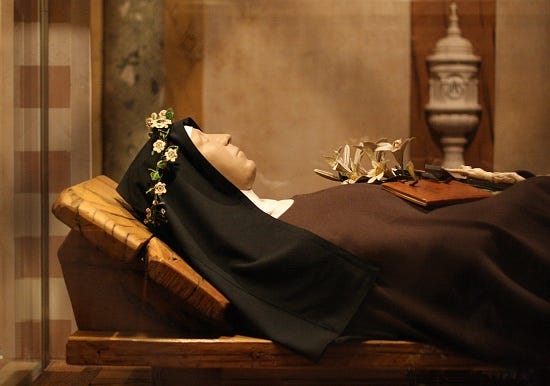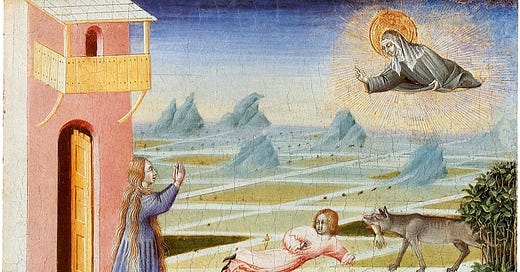Chiara Offreduccio was the eldest daughter of the Count of Sasso-Rosso, who planned to marry her off at the age of 12. Fortunately, Chaira got him to agree to wait until she was 18. As the date approached, she heard Francis of Assisi preaching a lenten homily, and, inflamed with a desire for the religious life, and with the support of her pious mother Ortolana, was presented to Francis on Palm Sunday 1212. She exchanged her rich gown for a poor Franciscan habit, and kneeling before him in the chapel of the Porziuncula, had her hair shorn and promised to follow the holy poverty of Francis.
She joined a group of Benedictine nuns until Francis had a small convent built near San Damiano, where she and a growing number of women could live much like the men who followed Francis. Eventually, against her will, Francis made her the abbess of the group, which would eventually include her mother and two of her sisters.
Little is known of her early life, and even her remaining letters and documents fill few pages, but she left a huge legacy as the founder of the Poor Ladies of San Damiano, who would become known as the Order of St. Clare, or the Poor Clares. She called herself “a little plant of our holy Father Francis,” but that little plant continues to blossom centuries later.

After their deaths, as the cults of both St. Francis and St. Clare grew, there was a kind of friendly competition between the two to work miracles, and if a request to one saint went unanswered, a petitioner would try the other. Some of the more superstitious faithful thought the “power” of Francis was fading as time passed after his death, but others knew that Francis was allowing his most faithful disciple her own chance to shine.
The early vita by Thomas of Celano (the likely author of the sequence “Dies irae”), retells several healing miracles wrought by in the intercession of Clare, but it was a rescue attempt that forms an interesting counterpoint to one of the most famous stories about St. Francis:
The countryside was wont to be disturbed by the ruthless ferocity of cruel wolves which attacked even men and often fed upon human flesh. There was a certain woman named Bona of Monte Galliano, in the diocese of Assisi, who had two sons. She had scarcely done weeping for one of them whom the wolves had carried off, when behold they hastened after the other one with the same rapacity.
For while the mother was indoors employed in some household work a wolf laid hold of the boy who was walking outside, and seizing him by the neck made off quickly to the wood with his prey.
Some men who were in the vineyards, hearing the boy's screams, called out to the mother, saying, "See whether thy son be with thee, for we have just heard some strange wailings."
The mother, realizing that her son had been snatched by a wolf, lifted her voice to heaven and, filling the air with her cries, invoked the virgin Clare, thus: "O holy and glorious Clare, give me back my poor boy; give back my little son to his unhappy mother. For if thou dost not, I shall drown myself."
The neighbors on running after the wolf found the infant in the wood, where he had been left by the beast, and a dog was beside the boy licking his wounds. The ferocious wolf had first fastened his fangs in the boy's neck, and had then caught hold of his side so that he might carry his prey off more easily, and had left no slight marks of the attack in both places.
The woman's prayer having been heard, she hastened together with her neighbors to her helper, showing the different wounds of the boy to all who wished to see them, and retuning abundant thanks to God and to St. Clare.
from
from The Life of St. Clare Virgin by Thomas of Celano, circa 1260
Of course, Francis was known to have tamed the ferocious Wolf of Gubbio, inspiring countless tales and works of art. The lesson: if you have wolf problems, take them to the Franciscans.
In another famous moment in St. Clare’s life, she is credited to holding off an army with the eucharist. 1240 and 1241, when Holy Roman Emperor Frederick II and his Saracen allies attacked Assisi, Clare rose from her sick bed and carried the eucharist to the city walls. The attackers fled. This is why she is often depicted holding a pyx or monstrance aloft.






